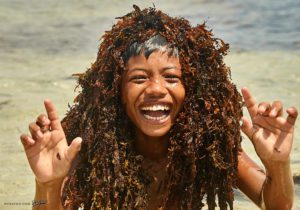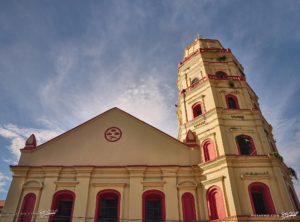
Tondol Beach: Discovering the Pristine Beauty of Anda Island in Pangasinan
Anda Island, also known as Cabarruyan, stands gracefully within the Pangasinan Province, adjacent to the renowned Hundred Islands. As one of the largest islands in
The Gabriela Silang Memorial Shrine, located in Sitio Pideg, Magsaysay, Santa, Ilocos Sur, is a poignant tribute to one of the Philippines’ most celebrated heroines. Nestled in her birthplace, this shrine honors Gabriela Silang‘s bravery and leadership in resisting Spanish colonial rule. The centerpiece of the memorial is a dramatic statue of Gabriela on horseback, brandishing a bolo, symbolizing her resolute spirit and warrior ethos.


The shrine is set within the Northern Luzon Heroes Hill National Park, a protected area established on July 9, 1963. Covering 1,316 hectares (3,250 acres) and rising to 465.4 meters, the park offers activities such as trekking, mountain biking, and sightseeing. It provides an excellent backdrop for those wishing to enjoy the natural beauty of the region while paying tribute to Gabriela Silang’s enduring legacy. Beyond being a historical landmark, the area serves as a space for reflection, allowing visitors to connect with the remarkable story of a woman who courageously led her people in their fight for freedom.



ABOVE: This aerial view shows the Northern Luzon Heroes Hill National Park facing the West Philippine Sea, now popular for swimming due to its blue waters. Established on July 9, 1963, the park spans 1,316 hectares (3,250 acres) and rises to 465.4 meters.
ABOVE: This aerial view shows the Northern Luzon Heroes Hill National Park facing the West Philippine Sea, now popular for swimming due to its blue waters. Established on July 9, 1963, the park spans 1,316 hectares (3,250 acres) and rises to 465.4 meters.
Gabriela was born in barrio Caniogan, Santa, Ilocos Sur, to Anselmo Cariño, a Spanish-Ilocano trader, and a Tinguian mother from a barrio in San Quintin, now known as Pidigan, Abra. Her father was involved in trade, transporting goods between Vigan and Abra along the Abra River, and was a descendant of Ignacio Cariño, one of the first Spaniards to settle in the region. Gabriela’s upbringing was heavily influenced by Catholicism, and she received her elementary education at a convent school under the guidance of the town’s parish priest.



ABOVE: This landmark sign along the road in Northern Luzon Heroes Hill National Park points to the shrine of Gabriela Silang, where visitors can trek, bike, and enjoy nature while honoring her legacy.
ABOVE: This landmark sign along the road in Northern Luzon Heroes Hill National Park points to the shrine of Gabriela Silang, where visitors can trek, bike, and enjoy nature while honoring her legacy.
After losing her parents early in life, Gabriela was raised by a local priest who arranged her marriage to a wealthy businessman in 1751. This marriage, however, was short-lived, as her husband passed away three years later, leaving Gabriela a young widow. Despite these early challenges, Gabriela’s resilience shone through, setting the stage for her future role in the struggle against Spanish rule.



Gabriela’s life took a significant turn when she met Diego Silang, a charismatic leader with revolutionary ambitions. They married in 1757, and together, they became a formidable team in the fight for Ilocano independence. In 1762, during the larger conflict of the Seven Years’ War, the British declared war on Spain and managed to seize control of Manila and Cavite. This geopolitical shift provided an opportunity for Diego to challenge the Spanish authorities in Ilocos.
Diego sought to replace Spanish officials with native-born leaders, aligning himself with the British, who appointed him as the governor of Ilocos on their behalf. Gabriela played a crucial role during this uprising, not only as Diego’s closest confidante but also as an active participant in military engagements. Her involvement in combat and strategic planning earned her respect and admiration, establishing her as a key figure in the resistance.




ABOVE: The Gabriela Silang Shrine in Northern Luzon Heroes Hill National Park invites history enthusiasts to explore its legacy through trekking, biking, and sightseeing.
ABOVE: The Gabriela Silang Shrine in Northern Luzon Heroes Hill National Park invites history enthusiasts to explore its legacy through trekking, biking, and sightseeing.
Tragedy struck on May 28, 1763, when Diego was betrayed and assassinated by his former allies, Miguel Vicos and Pedro Becbec, in Vigan. Devastated but undeterred, Gabriela fled to Tayum, a part of present-day Abra, where she sought refuge in her uncle Nicolás Cariño’s home. Determined to continue her husband’s cause, she appointed Miguel Flores and Tagabuen Infiel as her first generals, formally taking command of the rebel forces.


Under Gabriela’s leadership, the resistance grew bolder. She was revered by her followers as “La Generala,” a leader who embodied both strength and spirit. Her iconic image as a bolo-wielding warrior on horseback rallied her supporters, and her status as a “priestess” among her community underscored her deep connection with her people. Gabriela’s leadership was not just a continuation of her husband’s work but a powerful expression of her own vision and determination.


RELATED STORIES

Anda Island, also known as Cabarruyan, stands gracefully within the Pangasinan Province, adjacent to the renowned Hundred Islands. As one of the largest islands in

The Lingayen Beach is a public beach in Pangasinan Province, and is famous for hosting a Pista’y Dayat festival once every Labor Day. It has

Historically known as the co-cathedral of the Roman Catholic Archdiocese of Lingayen-Dagupan, the enormous Lingayen Cathedral or Parish Church of Epiphany of Our Lord has


On September 10, 1763, Gabriela made a daring attempt to capture Vigan, the stronghold of Spanish power in Ilocos. However, the Spanish forces mounted a fierce counterattack, forcing Gabriela and her troops to retreat once more to Abra. Despite their efforts to regroup, Gabriela and her forces were eventually overwhelmed and captured by the Spanish.
On September 20, 1763, Gabriela Silang and her followers were executed by hanging in Vigan‘s central plaza, marking the end of her brief but impactful leadership. Her death, however, did not extinguish the spirit of resistance she embodied. Gabriela Silang remains a symbol of courage and defiance against oppression, her legacy continuing to inspire generations. As the only national decoration exclusively for women, the Order of Gabriela Silang serves as a lasting tribute to her pioneering role in the fight for Philippine independence.
I’m looking forward to the stories and images leaving a lasting positive impression on you, just as they have on me. Stay connected with us on social media for a weekly exploration of travel assignments and breathtaking visuals. Our focus is on championing local tourism, showcasing small businesses, and honoring the magnificence of the Philippines through the content we curate. Join us in spreading the word by clicking the ‘share’ buttons below. Your support means the world to us.
EXPLORE MORE about

The Lingayen Beach is a public beach in Pangasinan Province, and is famous for hosting a Pista’y Dayat festival once every Labor Day. It has

Historically known as the co-cathedral of the Roman Catholic Archdiocese of Lingayen-Dagupan, the enormous Lingayen Cathedral or Parish Church of Epiphany of Our Lord has

Anda Island, also known as Cabarruyan, stands gracefully within the Pangasinan Province, adjacent to the renowned Hundred Islands. As one of the largest islands in
BROWSE BY CATEGORIES